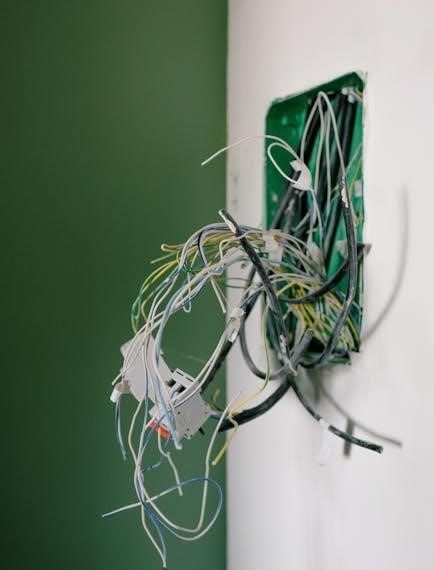plug size guide
Plug sizes are critical for ensuring safe and efficient electrical connections. Understanding their dimensions and types is essential for selecting the right plug for various applications and devices.
1.1 What Are Plug Sizes?
Plug sizes refer to the physical dimensions and configurations of plugs used to connect electrical devices. They vary in shape, prong count, and voltage capacity to suit different applications. Understanding plug sizes ensures compatibility and safety. Common types include household plugs, industrial plugs, and specialized plugs for marine or aerospace use. Each size is designed to meet specific power requirements, ensuring efficient and secure connections. Proper plug sizing is crucial to prevent electrical hazards and maintain optimal performance.
1.2 Importance of Understanding Plug Sizes
Understanding plug sizes is crucial for ensuring safety, efficiency, and compatibility in electrical connections. Incorrect plug sizes can lead to hazards like overheating or electrical fires. Proper sizing ensures devices receive the right power, optimizing performance and longevity. It also prevents damage to appliances and circuits. Additionally, recognizing regional plug size standards is essential for international use, avoiding incompatibility issues. Knowledge of plug sizes helps in selecting the right tools and ensuring reliable connections, making it a fundamental aspect of electrical safety and functionality.

Types of Plugs and Their Sizes
Plugs vary in size and type, including household, industrial, and specialized options. Each category serves specific applications, ensuring safe and efficient electrical connections across different devices and systems.
2.1 Household Plug Sizes
Household plugs come in various sizes to accommodate different power requirements. Common sizes include 15-amp and 20-amp plugs, with prong configurations varying by region. For example, Type A plugs are standard in North America, with two flat prongs, while Type C plugs in Europe feature two round prongs. Larger appliances often require 30-amp or 50-amp plugs with more prongs, ensuring safe and efficient power delivery. Proper plug size selection prevents overloading and enhances safety in residential settings.
2.2 Industrial Plug Sizes
Industrial plugs are designed for heavy-duty applications, requiring higher power ratings. Common sizes include 30-amp, 50-amp, and 60-amp plugs, often with specialized configurations. These plugs feature rugged designs to withstand harsh environments and high electrical loads. They are typically larger and have more prongs than household plugs, ensuring safe and reliable connections. Proper selection of industrial plug sizes is crucial to prevent overheating and maintain operational efficiency in manufacturing and commercial settings.
2.3 Specialized Plug Sizes (e.g., Marine, Aerospace)
Specialized plugs cater to unique environments, such as marine and aerospace applications. Marine plugs are designed to withstand moisture and corrosion, often featuring waterproof ratings. Aerospace plugs prioritize high-temperature resistance and durability, ensuring reliability in extreme conditions. These plugs are built to meet specific industry standards, with sizes and configurations tailored to their intended use. Proper selection is critical to ensure safety and performance in these demanding settings, where failure could lead to significant operational risks.

How to Choose the Right Plug Size
Selecting the right plug size involves considering voltage, current, and application type. Proper sizing ensures safety, efficiency, and compatibility with electrical systems and devices.
3.1 Factors to Consider When Selecting a Plug Size
When selecting a plug size, consider voltage, current, and application type. Proper sizing ensures safety, efficiency, and compatibility with electrical systems and devices. Always match the plug size to the appliance’s requirements to avoid risks of overheating or electrical failure. Additionally, regional standards and safety certifications should be checked to ensure compliance with local regulations. Proper installation tools and techniques are also essential for a secure and reliable connection. Accurate measurement and understanding of plug size charts are crucial to make the right choice.
3.2 How to Read Plug Size Charts
Plug size charts are essential tools for matching plugs to devices. They typically display voltage, current, and physical dimensions. Start by identifying the device’s requirements from its manual. Locate the corresponding row and column in the chart to find the correct plug size. Pay attention to key specifications like amp rating and voltage range. Use online size guides or manufacturer resources for clarity. Always cross-verify measurements to ensure compatibility and safety. Proper interpretation helps avoid mismatches and potential electrical hazards.
3.3 Common Mistakes to Avoid
One common mistake is assuming all plugs are universal, which can lead to unsafe connections. Overlooking voltage and current ratings is another error. Mismatching plug types for devices can cause damage or fire hazards. Using incorrect adapters without verifying compatibility is risky. Neglecting to measure plug dimensions accurately can result in poor fits. Always check regional standards and manufacturer guidelines to avoid these pitfalls. Proper plug selection ensures safety, efficiency, and longevity of electrical systems and appliances.
Applications and Compatibility
Plug sizes vary by region and device type, ensuring compatibility and safety. Understanding these differences is crucial for proper electrical connections and appliance functionality worldwide.
4.1 Regional Differences in Plug Sizes
Regional differences in plug sizes are significant due to varying electrical standards worldwide. For instance, Type A plugs are common in North America and Japan, featuring two flat prongs, while Type C plugs, used in Europe, have two round pins. Other regions like the UK use Type G plugs with three rectangular prongs, ensuring safety and compatibility with local power systems. These variations highlight the importance of adapters for international travel and appliance use.
4.2 Plug Size Compatibility with Appliances
Ensuring plug size compatibility with appliances is crucial for safety and performance. Always match the plug’s voltage and current ratings to the appliance’s requirements. Using the wrong size can lead to overheating, damage, or electrical hazards. Check the appliance’s manual for specific plug recommendations. Adapters or plug replacements may be necessary for compatibility. Never force a plug into a socket, as this can cause permanent damage. Proper compatibility ensures reliable operation and extends the lifespan of both the plug and the appliance.
Measurement and Installation
Accurate measurement ensures proper plug fitment. Use calipers to measure prong width and spacing. Installation requires tools like wire strippers and screwdrivers. Follow safety guidelines strictly always.
5.1 How to Measure Plug Sizes Accurately
Accurate plug size measurement is crucial for compatibility. Use digital calipers to measure the width and height of the prongs. Note the spacing between prongs and overall plug length. Ensure the tool is set to millimeters for precision. Compare measurements with manufacturer charts to confirm size. Incorrect measurements can lead to unsafe connections, so double-check your readings. Always refer to the appliance’s specifications for optimal fit and functionality.
5.2 Tools and Techniques for Installing Plugs
Installing plugs requires the right tools and techniques to ensure safety and efficiency. Use wire cutters for trimming cables, screwdrivers for securing connections, and plug testers to verify functionality. Properly strip insulation from wires before attaching them to terminals. Tighten screws firmly but avoid over-tightening, which can damage the plug. Always refer to the plug size chart for compatibility. Following these steps ensures a secure and reliable electrical connection, preventing potential hazards and ensuring optimal performance.
Safety Considerations
Adhering to safety standards is crucial when working with plugs. Incorrect plug sizes can lead to hazards like electrical fires or shocks, emphasizing the need for caution.
6.1 Safety Standards for Plug Sizes
Safety standards for plug sizes ensure compatibility and prevent hazards. These standards, often set by organizations like IEC or NEMA, specify voltage, current, and physical dimensions to guarantee safe connections. Compliance with these standards is essential to avoid risks such as overheating, electrical fires, or shocks. Properly rated plugs maintain electrical integrity, ensuring devices operate efficiently. Always verify that plugs meet regional and international safety certifications to uphold safety and reliability in any electrical setup or appliance connection.
6.2 Risks of Using the Wrong Plug Size
Using the wrong plug size can lead to serious safety hazards, including electrical fires, overheating, and appliance damage. Incorrect plugs may not provide proper voltage or current ratings, causing malfunction or failure. This mismatch can also result in poor connections, leading to arcing or short circuits. Additionally, incompatible plugs may not meet regional safety standards, posing significant risks to both devices and users. Always ensure plug sizes align with appliance requirements to prevent accidents and maintain operational efficiency and safety.

Troubleshooting Common Issues
Troubleshooting plug-related problems often involves identifying size mismatches, loose connections, or incompatible voltage ratings. Regular inspection and adherence to safety standards can prevent most issues effectively.
7.1 Identifying Plug Size Mismatches
Identifying plug size mismatches involves checking for physical fit and compatibility with the socket or appliance. Look for loose connections, incorrect voltage ratings, or improper prong alignment. Using a plug size chart can help verify compatibility. If a plug doesn’t fit securely, it may cause safety hazards or malfunction. Ensure all plugs match the recommended specifications for safe and efficient operation. Regular inspections can prevent such mismatches and ensure optimal performance.
7.2 Solutions for Common Plug-Related Problems
Common plug-related issues often stem from size mismatches or wear. To resolve these, use adapters for regional differences and replace worn-out plugs. Ensure plugs match appliance voltage and current ratings. Regular maintenance, like cleaning contacts, prevents connectivity issues. For complex problems, consulting a professional is advisable. Always follow safety guidelines to avoid hazards. Proper tools and techniques can also help in troubleshooting and installing plugs effectively, ensuring reliability and safety in electrical connections.

Charts and Diagrams
This section provides visual guides, including plug size comparison charts and installation diagrams, to help users understand and identify the correct plug sizes for their needs.
8.1 Plug Size Comparison Charts
Plug size comparison charts are essential visual tools for identifying and selecting the correct plug sizes. These charts typically include detailed measurements, types of plugs, and compatibility standards. They help users quickly compare different plug sizes side by side, ensuring accurate selection for various applications. By providing a clear overview of plug dimensions and shapes, these charts simplify the process of choosing the right plug for specific devices or systems. They are particularly useful for homeowners, electricians, and professionals needing to match plugs with compatible outlets or appliances efficiently.
8.2 Visual Guides for Plug Installation
Visual guides for plug installation provide step-by-step instructions through images and diagrams, making the process easier to understand. These guides often include detailed illustrations of plug components, wire connections, and safety precautions. They help users identify the correct tools and techniques required for installation. By breaking down complex steps into visual sequences, these guides ensure that even inexperienced individuals can install plugs safely and efficiently. They are invaluable for both professionals and DIY enthusiasts, promoting accuracy and reducing errors during the installation process.
Understanding plug sizes is crucial for safety and efficiency. Selecting the right plug ensures reliable connections. Stay informed about advancements in plug technology for future applications.
9.1 Summary of Key Points
Understanding plug sizes is vital for safety and efficiency in electrical connections. Key factors include voltage, current, and regional compatibility. Proper plug selection prevents mismatches and ensures optimal performance. Always refer to charts and guides for accurate measurements. Safety standards and installation techniques are critical to avoid risks. By adhering to these guidelines, users can achieve reliable and secure electrical connections. Future advancements in plug technology will likely enhance compatibility and safety further, making it essential to stay informed.
9.2 Future Trends in Plug Size Technology
Future plug size technology is expected to focus on universal compatibility and smart features. Advancements like wireless charging and compact, multi-purpose designs are gaining traction. Eco-friendly materials and energy-efficient plugs are also on the rise. Smart plugs with integrated sensors may become standard, offering real-time energy monitoring. Additionally, modular plug systems could allow users to customize sizes and configurations. These innovations aim to enhance convenience, sustainability, and safety in electrical connections, shaping the future of plug technology.
